 Woodstove Installation
Woodstove Installation
Safe installation of a woodstove to replace a zero-clearance fireplace
- POST a QUESTION or COMMENT about converting a zero-clearance fireplace installation to a wood-burning woodstove installation
Installing a woodstove in an existing fireplace opening:
This article discusses the safety questions that arise if you are installing a wood burning stove - a woodstove - where there is an existing fireplace or an existing zero-clearance fireplace - a case giving rise to special fire clearance worries. What components of the existing fireplace are safe to use? How do we assure that the wood stove installation will be proper and safe?
InspectAPedia tolerates no conflicts of interest. We have no relationship with advertisers, products, or services discussed at this website.
- Daniel Friedman, Publisher/Editor/Author - See WHO ARE WE?
Convert a Zero-Clearance Fireplace to a Woodstove Installation
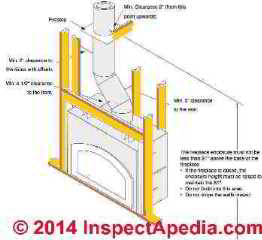 Reader Question: who can install a woodstove where we have a zero clearance fireplace?
Reader Question: who can install a woodstove where we have a zero clearance fireplace?
I'd like your opinion as to what type of contractor I need, or if we need one at all.
We have a 1990's Lindal log home with a heatilator fireplace installed. I believe this is a zero clearance fireplace with no actual masonry except for the faux rock surrounding it.
[Click to enlarge any image]
We would like to have a wood burning stove instead.
- Either a stove on the hearth with the chimney going back inside the fireplace and up the existing flue/pipe,
or
- Remove the entire heatilator fireplace. This is my choice and my husband votes for the prior.
If we remove the entire heatilator, I don't think there is any actual masonry inside the rectangular "chimney".... So, we don't know if this is a major construction project that needs a Mason to do it, or if this is a simple task and a fireplace shop could do it. (Of course we'd have to buy their wood stove.
Can you tell me what kind of company I should be dealing with to take this on? - S.D. 11/30/2014
Reply:
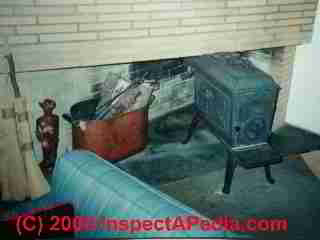 The topics we need to consider when thinking about installing a woodstove into an existing fireplace include at least these:
The topics we need to consider when thinking about installing a woodstove into an existing fireplace include at least these:
- SAFETY:
be sure to obtain required permits and approvals for the new wood-stove installation. It may seem like more trouble but inspections by a professional or a code compliance officer might help avoid a house fire. - CHIMNEY USABILITY or ACCESS -
is there a usable chimney to which the new woodstove can be connected and if so where can and should the connection be made. Generally we can't share a flue used by some other heating equipment.
We might be able to make use of an existing fireplace chimney if the existing fireplace burned the same fuel as the new stove: wood.
See SHARED CHIMNEY & FLUE HAZARDS - FIRE CLEARANCE DISTANCES -
from the wood stove to nearby combustibles will be different than for an existing, built-in fireplace. Don't count on using a narrow existing hearth.
See FIRE CLEARANCES INDOORS - FUEL -
if the existing fireplace was a zero-clearance until that burned gas fuel it is unlikely that the fireplace enclosure nor its chimney can be used with a wood burning stove. - WOOD STOVE CHOICE -
choose a model that is not over-sized for the space to be heated, and consider the wood stove dimensions versus where it has to fit.
Above next to your question I have included a sketch of a typical zero-clearance fireplace installation to show how framing surrounds the fireplace.
The image is adapted from an installation manual provided by Travis Industries and cited atReferences or Citations .
The studs are wood or in some installations the manufacturer requires that metal studs be used. Shown is a zero clearance fireplace that uses a vertical chimney.
Some zero-clearance fireplace units such as those heating by a gas log rather than burning actual firewood may vent horizontally out through a wall with no actual chimney.
Other zero-clearance fireplaces include a blower unit and outdoor air circulation around the unit serving in part as a source of cooling to reduce fire risk.
See FIREPLACE INSERTS INSTALL, INSPECT, REPAIR for more about zero-clearance fireplaces.
And
see FIREPLACE INSPECTION PRE-FAB to assess the condition of the existing zero clearance fireplace.
Other features such as the fireplace hearth are not shown in this drawing but are usually present. The typical fireplace hearth will be too small to carry a conventional woodstove, as you'll see in our photograph at left.
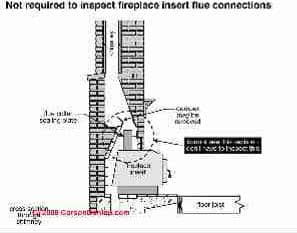 ZERO CLEARANCES [Image]
ZERO CLEARANCES [Image]
These features do not immediately fit a conventional woodstove installation in the same location without substantial modifications.
I'd be very careful about trying to make any use of the existing zero clearance fireplace to support a woodstove - the temperatures, fire clearances, other safety variables are just too unknown.
It would be more straightforward to remove the existing fireplace, inspect the chimney for type and condition so as to determine if it's usable for a different heating appliance, and consider also modifications to permit safe fire clearance distances around any connections to the new chimney - as well of course as fire clearance distances and heat shielding for the new woodstove itself.
See FIRE CLEARANCES INDOORS.
You can probably install a woodstove with adequate heat shielding and provided it is connected to a properly-sized chimney approved for that appliance.
Start by choosing the woodstove by size and type and by noting where you think it might fit. Don't buy one that's too large or you'll not be able to run it hot enough to avoid creosote issues.
Companies who sell wood and coal stoves often provide installation services, as do some certified chimney sweeps (Chimney Sweeps Guild Members).
Hire a wood stove installer based in part by how receptive the installer is to obtaining a building permit - as is required in most jurisdictions. An installer who is familiar with local fire codes and who welcomes appropriate approval inspections by your fire inspector, combined with those actual inspections, should make the job safer - so we all can sleep better.
Don't forget proper smoke detectors and in my OPINION I'd want a couple of properly-rated fire extinguishers - placed close to nearby exit doors.
Reader follow-up:
We've wanted to do this for almost 2 years now and always come to a wall. There is really nothing out there that I can find about un-installing a heatilator fireplace.
One fireplace guy told us we could probably do the hearth thing if we found a stove that had a flue hole out the back, and another told us it should be removed, but really didn't want to do it. Mostly because it is all mortared into the faux rock. I will take your suggestion and find a dealer who has a stove we like and work with them.
I had kind of hoped for an antique stove, but will nix that idea. With an all cedar house, probably better to go the safest route. - S.D. 12/1/2014
Reply:
Basically a zero clearance fireplace insert is a metal fireplace inserted into a wood-framed opening and connected usually to a metal chimney that passes to above the roof in a wood-framed chimney chase. There is little in that structure that would be useful for a woodstove installation except possibly making use of the chimney.
And for zero clearance fireplaces that vent horizontally out through a building wall there is in essence no chimney that would be useful for a conventional woodstove in that location, though the wall opening might be used to pass a properly-rated metal chimney out through the wall to connect to a new vertical metal chimney.
The fireplace guy you spoke with about a woodstove with a flue hole in the back is on track. The wood stove height and the routing of its flue vent connector between stove and chimney are key in determining how to connect a new wood stove to an existing chimney.
If your woodstove is not able to use the existing fireplace chimney,
see SUPER CHIMNEYS, 629 CHIMNEYS designed for use with wood stoves and wood burning appliances.
That is, all of the heat and fire safety of the insert depended on its own construction and on clearances from combustible framing in the insert opening.
Typically a woodstove will not fit within the original opening for a zero-clearance fireplace and still meet safe fire clearance distances unless it is quite small and unless adequate heat shielding can be installed. In particular it would be difficult to meet the overhead fire clearance distances for a woodstove it were stuck into the insert opening. And it certainly won't fit into a fireplace insert that were left in place.
See also FIREPLACE DAMAGE & UNSAFE HEARTHS
More likely you'd remove the fireplace and then either close off the opening and install the woodstove out into the room or you'd have to re-frame the opening to make it much larger.
See what your woodstove installer has to say and let us know.
Woodstove & Wood / Coal Furnace Installation Manuals
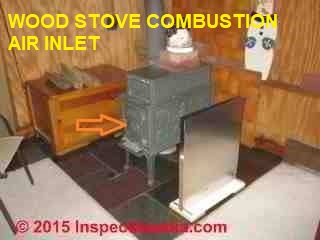 Watch out: for safe as well as effective operation be sure to obtain and follow the wood stove installation permit requirements, installation, use, and maintenance instructions for your specific wood stove or pellet stove brand and model.
Watch out: for safe as well as effective operation be sure to obtain and follow the wood stove installation permit requirements, installation, use, and maintenance instructions for your specific wood stove or pellet stove brand and model.
Failure to do so risks a building fire or worse.
In addition, in most jurisdictions a building permit, inspections, and approvals are required to install a wood or pellet stove. Those inspections help assure that your wood stove installation is more-safe.
- Ardent Energy FORCED AIR WOOD FURNACE INSTALLATION & OPERATION MANUAL [PDF] Models F75R & F101, Ardent Energy, Box 3637, Smithers BCJ V0J 2N0 Canada, retrieved 2022/02/25 original source: http://ardentenergy.ca/pdf/furnace_manual.pdf
- Blaze King PRINCESS CATALYTIC WOOD STOVE INSTRUCTIONS [PDF] Valley Comfort Systems Inc., 1290 Commercial Way, Penticton, BC, V2A 3H5, Canada In Canada: Phone 250-493-7444, Fax 250-493-5833 In USA: Phone 509-522-2730, Fax 509-522-1701 web: www.blazeking.com, email: info@blazeking.com
- Blaze King CATALYST STOVE INSTALLATION & OPERATION [PDF] Models: KE1107, KEJ117, Princess PE1006 / PEJ1106,
Valley Comfort Systems Inc. 1290 Commercial Way Penticton, BC V2A 3H5 CANADA Phone: 250-493-7444 Fax: 250-493-5833
and
Blaze King Industries 146 A Street Walla Walla, WA 99362 U.S.A. Phone: (509) 522-2730 Fax: (509) 522-9803 - BLAZE-KING KE40 CATALYTIC WOOD STOVE MANUAL [PDF] (2021) - Blaze King, Valley Comfort Systems Inc., cited above, op. cit.., - retrieved 2021/12/05, original source: https://www.blazeking.com/wp-content/uploads/2021/07/180-KE40-july2021.pdf
- CATALYTIC WOODSTOVE INSTALLATION - INSTALLATION, OPERATION, MAINTENANCE - [PDF] U.S. EPA, Environmental Protection Agency - retrieved 2021/12/05 original source: https://www.epa.gov/sites/default/files/2013-09/documents/catalytic.pdf
- CATALYTIC WOOD STOVE OPERATION [PDF] Gulland Associates, original source: https://urbanhearth.ca/handouts-new/45-how-to-operate-your-catalytic-stove/file
Excerpts: Catalytic wood stoves reduce smoke emissions by passing the smoke through a catalyst. Non-catalytic stoves use a different strategy. But there are some guidelines that are common to all wood stoves.
A wood stove catalyst is either a ceramic or metal honeycomb that is coated with a metal, platinum and/or palladium. When smoke flows through the small passages in the combustor, passing close to the catalytic coating, its ignition temperature is reduced by roughly half, from about 1000°F to 500°F.
This low ignition temperature allows a catalytic stove to produce a long steady burn with a low emission level. The catalytic coating is not consumed in the process, although it and the surface it coats degrades as it is used.
The combustor is at the heart of the catalytic stove and to remain healthy it must be hot enough to be active, but not so hot that it is damaged. The bypass damper is used to bypass the combustor when the loading door is open and when the exhaust is not yet hot enough to make it active.
The flame shield protects the combustor from direct flames which can cause uneven heating and shock to the combustor.
Temperature is Important
The catalyst becomes active when it is heated above 500°F. When it is active and is fed some smoke, its temperature rises rapidly as the smoke burns.
This is usually referred to as ‘light off’. Once the catalyst and the surrounding materials are heated beyond the activation temperature, the smoke entering the catalyst can be cooler than 500°F because combustion inside creates the heat needed to sustain catalytic combustion.
A catalytic combustor that is being fed dense wood smoke may glow bright red and reach temperatures as high as 1600°F, which can damage the combustor if allowed to continue. To avoid damage, don’t run the stove continuously at maximum, except for up to 30 minutes as it heats up after loading. - Drolet TUNDRA II WOOD FURNACE INSTALLATION/OPERATION MANUAL [PDF] Stove Builder International Inc. 250, rue de Copenhague, St-Augustin-de-Desmaures (Quebec) Canada G3A 2H3 After-sale service: 418-908-8002 E-mail: tech@sbi-international.com
- Drolet Heat Commander WOOD FURNACE INSTALLATION & OPERATING INSTRUCTIONS [PDF] Model DF02003, Op. Cit.
- Energy King WOOD / COAL FURNACE INSTALLATION & OPERATION MANUAL [PDF] Models EK365, EK385, EK480, Energy King, 325 South Park St., Reedsburgh WI 53939 USA Tel: 800-944-2516, Web: www.EnergyKing.com
- Helwig, Larry, & Mary Ann Sward, WOOD STOVE AND FIRE AND FIREPLACE SAF EPLACE SAFETY AND MAINTENANCE [PDF] (1979) South Dakota State University Cooperative Extension Service, &. U.S. Department of Agriculture
- Kerr Controls, SCOTSMAN WOOD FURNACE OWNERS MANUAL [PDF] Model DB-101, Kerr Controls, Halifax 3611 Commission St B3K 2S3 Nova Scotia, Canada, Tel: 1-800-565-7573 Phone: (902) 455-7248, locations also in Dartmouth, Truro, & Sydnet NS, retrieved 2022/02/25 original source: https://kerrcontrols.ca/wp-content/uploads/2019/08/SCOTSMAN-WOOD-FURNACE-MANUAL.pdf
- Lopi, PATRIOT WOOD STOVE OWNERS MANUAL [PDF] (2005) Travis Industries
- NEWMAC WOOD-COAL FURNACE INSTALLATION OPERATION SERVICE MANUAL [PDF] (2010) WOOD-COAL FURNACE WG-100 WOOD-COAL-ELECTRIC WG-100E WOOD FURNACE WB-100 WOOD-ELECTRIC FURNACE WB-100E - Newmac Mfg. Inc. 208 Lancaster Crescent P.o. Box 9, Debert Nova Scotia, Bom 1g0 Phone: 902-662-3840 Fax: 902-662-2581 Warehouse Newmac Mfg. Inc. 430 Springbank Ave., South Woodstock, Ontario N4v 1b2 Phone: 519-539-6147 Fax: 519-539-0048 Email: Newmac@newmacfurnaces.com
- PSG CADDY FURNACE INSTALLATION / OPERATION MANUAL [PDF] (2015) Model PF01010, PSG Eco-Energy, 250, de Copenhague,
St-Augustin-de-Desmaures (Quebec)
CANADA G3A 2H3, retrived 2022/02/25 original source: https://www.caddyfurnaces.com/media/1029/45535a_17-06-2015.pdf
Excerpt re: Warranty coverage -
This warranty applies to normal residential use only. Damages caused by misuse, abuse, improper installation, lack of maintenance, over firing, negligence or accident during transportation, power failures, downdrafts, or venting problems are not covered by this warranty. - ROYALL WOOD FURNACE MANUAL [PDF] Royall Furnace, 325 South Park St., Reedsburg WI 53959 USA, Tel: 800-944-2516, Web: www.Royallproducts.com and https://www.royallfurnace.com/ Email: info@Royallproducts.com (Ark Alloy, LLC) - retrieved 2022/02/05 original source: https://www.royallfurnace.com/manual/royall-furnace-manual.pdf
- Travis Industries, 36 ELITE INSTALLATION MANUAL, WOOD-BURNING ZERO-CLEARANCE FIREPLACE [PDF] (2021) Travis Industries House of Fire, 12521 Harbour Reach Drive
Mukilteo, WA 98275
USA
French language manuals at fireplacex.com Manuels de langue Française à fireplacex.com 4800 Harbour Pointe Blvd. SW, Mukilteo, WA 98275, (2010), Website: http://www.travisindustries.com/ - retrieved 12/1/2014, original source: http://www.fireplacex.com/TravisDocs/93508090.pdf.
This wood burning zero clearance fireplace was tested and listed by Omni Test Laboratories, Beaverton OR, Report # 028-F-60-4, meeting U.L. 127 & portions of UL 1482 & 907. Retrieved again 2022/02/25 - US Stove, ASHLEY WOOD & COAL BURNING FURNACE MANUAL [PDF] United States Stove Co., 227 Industrial Park Road
P.O. Box 151
South Pittsburg, TN 37380 USA,
Excerpt:
OVER FIRING
This generally occurs when the following procedures are not followed, ash door is open (even partially open), the feed door pressure relief flap is open, the feed door is open or the manual draft spinner is open.
Open the ash and feed doors only when in attendance, never leave the furnace unattended when doors are open. This furnace has an automatic draft fan so use the manual draft with a specific purpose.
Also, an overfilled ash drawer can cause grate warpage, keep ash drawer clean. Don't use furnace if distribution fan isn't functioning properly, and keep air filter clean. Draft fan opening should be set at 1/2" open as a point of start, depending on condition of fuel. U. S. Stove recommends a very active fire at all times for maximum results, but only as instructed. - Vermont Castings ENCORE® FLEXBURN® NON-CATALYTIC/ CATALYTIC WOOD BURNING STOVE INSTALLATION & OPERATION MANUAL [PDF] Model 2040, (2019) Vermont Castings, 352 Mountain House Road, Halifax, PA 17032
USA Web: www.vermontcastings.com
Excerpt:
Watch out: TO REDUCE THE RISK OF FIRE, FOLLOW THE INSTALLATION INSTRUCTIONS. FAILURE TO FOLLOW INSTRUCTIONS MAY RESULT IN PROPERTY DAMAGE, BODILY INJURY OR EVEN DEATH. CONTACT LOCAL BUILDING OFFICIALS ABOUT RESTRICTIONS AND INSTALLATION INSPECTION REQUIREMENTS IN YOUR AREA.
- Vermont Castings INTREPID WOOD STOVE CATALYTIC COMBUSTER INSTRUCTIONS [PDF] (2019) Vermont Castings Stove Co., 352 Mountain House Road , Halifax, PA 17032 USA, Website: www.vermontcastings.com - retrieved 2021/12/05
- Vermont Castings RESOLUTE ACCLAIM WOODSTOVE MANUAL [PDF] (2011) Model 2490 Homeowner's Installation & Operating Manual, Op. Cit.,
- Woodstock IDEAL STEEL HYBRID WOODSTOVE MANUAL [PDF] (2020) Gear Head Stoves, Woodstock Soapstone Company, Inc. 66 Airpark Road, West Lebanon, NH 03784 USA Tel: 1-800-866-4344 Website: www.woodstove.com
- Pellet stove manual are given separately
at PELLET STOVE MANUALS
...
Reader Comments, Questions & Answers About The Article Above
Below you will find questions and answers previously posted on this page at its page bottom reader comment box.
Reader Q&A - also see RECOMMENDED ARTICLES & FAQs
On 2022-01-30 by Inspectapedia Com Moderator (mod) - log home zero-clearance fireplace fire report
@Johnfkleinjr,
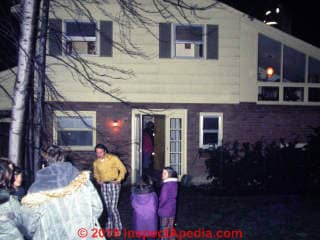 Thanks so much for the log home zero-clearance fireplace fire report and photo.
Thanks so much for the log home zero-clearance fireplace fire report and photo.
I'm particularly sensitive to this hazard as my first home caught fire
at FIREPLACES & HEARTHS
I include a photo of us evacuating the house on fire back in 1969.
That was New York where there are fireplace codes, but the fireplace was built improperly, resulting in the house catching fire on New Year's Eve.
Your photo illustrates that even more-so in code-free areas, building or installing a fireplace still needs to be done properly lest the builder else kill someone.
If you can add more details about exactly how the fireplace was installed that will be most helpful.
I think that even in a log home, as in any wood framed home, if a zero-clearance fireplace is installed following the manufacturer's instructions, it can be safe.
On 2022-01-30 by Johnfkleinjr
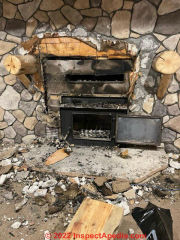 I'm a home inspector in Colorado and inspect Log Homes periodically, typically in remote areas. I had a home owner contact me recently that had a fire in their log wall around a retro fitted wood burning unit.
I'm a home inspector in Colorado and inspect Log Homes periodically, typically in remote areas. I had a home owner contact me recently that had a fire in their log wall around a retro fitted wood burning unit.
They've been told by a reputable log home restoration contractor that the entire unit and chimney need to be removed to repair the log wall.
They need an additional perspective grounded in a recognized code or standard to make a case to their insurance company because they live in a county that has not code requirements.
I've attached a picture of the unit after the fire. (note: the CMUs around the unit are hollow, most notably the CMUs along the top.)
Any advice or guidance is greatly appreciated.
On 2021-08-03 by inspectapedia.com.moderator (mod) - how much head clearance from the mantle is needed
@Kerrie,
I don't know any of the specifics of your unit so I can't make a answer that is for certain but it's quite possible that the unit is not safe to use when the fan doesn't work. In at least some designs the unit could overheat and there could be a fire hazard.
You need to identify the model and brand and get ahold of the service and installation manual to read the operating instructions to know the role of your unit's fan and whether or not it is required for safety to avoid overheating.
On 2021-08-02 by Kerrie
We have a 30 yr old zero clearance wood burning insert. The fan has stopped working under the unit. Is it still safe to use? This is a small unit, would you recommend a small free standing firebox unit that would vent out the back and be tied into our existing chimney (professionally done).
This unit would stick into the zero clearance box half way, the other half would be on the hearth. The flooring is a concrete Overlay that is around the hearth. How much head clearance from the mantle would be needed if it is sticking out maybe 10"?
On 2018-10-15 by danjoefriedman (mod) - insert a zero clearance fireplace insert or woodstove insert that meets the manufacturer's specified fire clearances
Thanks for the comment, Neil.
I agree that the first choice is to insert a zero clearance (ZC) fireplace insert or woodstove insert that meets the manufacturer's specified fire clearances to combustibles (including wood framing) without having to modify the framing.
If you modify framing to remove anything the strength and stability of the structure needs to be understood and assured, possibly by adding support elsewhere.
A flue or fire-rated chimney assembly that hangs from the roof structure is indeed often a helpful means of providing safe venting of combustion gases but it doesn't address the fire clearance of the insert itself.
On 2018-10-15 by Neil
There is a 2x4 and a header directly on the sides and top of every zero clearance. If your stove can be placed far enough away from that framing to achieve spec'd clearance, and the stove pipe fits into the existing then there is no problem.
If you remove the ZC the flu will not be supported any longer, must be removed, and you will, pretty much, be working from scratch with a hopeful adapter at the roof to save a few bucks.
...
...
Continue reading at FIRE CLEARANCES, WOOD COAL & PELLET STOVES or select a topic from the closely-related articles below, or see the complete ARTICLE INDEX.
Or see these
Recommended Articles
- CHIMNEY CLEANING PROCEDURES
- CHIMNEY DRAFT & PERFORMANCE
- CHIMNEY FIRE ACTION / PREVENTION
- CHIMNEY FLUE INSPECTION CAMERA
- CREOSOTE FIRE HAZARDS
- DRAFT MEASUREMENT, CHIMNEYS & FLUES
- FIRE CLEARANCES INDOORS
- FIRE CLEARANCES, MASONRY CHIMNEYS
- FIRE CLEARANCES, METAL CHIMNEYS
- FIREPLACES & HEARTHS - home
- FIREPLACE INSERTS INSTALL, INSPECT, REPAIR - home
- GAS FIREPLACES & GAS LOGS - home
- METAL CHIMNEYS & FLUES - home
- METAL CHIMNEY INSTALLATION MANUALS
- WOOD-OIL COMBINATION HEATERS - home
- WOOD STOVE OPERATION & SAFETY - home
- COMBUSTION AIR for WOODSTOVES
- DEFECTS LIST - HEAT, WOOD APPLIANCE
- FIRE CLEARANCES, WOOD COAL & PELLET STOVES
- FIREPLACE INSERTS INSTALL, INSPECT, REPAIR
- HEAT SHIELD SPECIFICATIONS for WOOD STOVES & PELLET STOVES
- PELLET STOVE CLEARANCE DISTANCES
- PELLET STOVE DRAFT CONTROL
- PELLET STOVE MANUALS
- WOOD FURNACE FAN LIMIT CONTROL
- WOOD FURNACE INSTALLATION MANUALS
- WOODSTOVE DRAFT CONTROL
- WOOD STOVE DRAFT TEST
- WOOD STOVE, CATALYTIC PUFF-BACKS
- WOOD STOVE INSTALL CONVERT
- WOOD STOVE INSPECTION CHECKLIST [PDF]
- WOOD STOVE MANUALS
Suggested citation for this web page
WOOD STOVE INSTALL CONVERT at InspectApedia.com - online encyclopedia of building & environmental inspection, testing, diagnosis, repair, & problem prevention advice.
Or see this
INDEX to RELATED ARTICLES: ARTICLE INDEX to BUILDING FIRE SAFETY
Or use the SEARCH BOX found below to Ask a Question or Search InspectApedia
Ask a Question or Search InspectApedia
Try the search box just below, or if you prefer, post a question or comment in the Comments box below and we will respond promptly.
Search the InspectApedia website
Note: appearance of your Comment below may be delayed: if your comment contains an image, photograph, web link, or text that looks to the software as if it might be a web link, your posting will appear after it has been approved by a moderator. Apologies for the delay.
Only one image can be added per comment but you can post as many comments, and therefore images, as you like.
You will not receive a notification when a response to your question has been posted.
Please bookmark this page to make it easy for you to check back for our response.
IF above you see "Comment Form is loading comments..." then COMMENT BOX - countable.ca / bawkbox.com IS NOT WORKING.
In any case you are welcome to send an email directly to us at InspectApedia.com at editor@inspectApedia.com
We'll reply to you directly. Please help us help you by noting, in your email, the URL of the InspectApedia page where you wanted to comment.
Citations & References
In addition to any citations in the article above, a full list is available on request.
- India: Shrimali, Gireesch et als, "Improved Stoves in India: A Study of Sustainable Building Models", Abstract:
Burning of biomass for cooking is associated with health problems and climate change impacts. Many previous efforts to disseminate improved stoves – primarily by governments and NGOs – have not been successful. Based on interviews with 12 organizations selling improved biomass stoves, we assess the results to date and future prospects of commercial stove operations in India. Specifically, we considerhow the ability of these businesses to achieve scale and become self-sustaining has been influenced by six elements of their respective business models: design, customers targeted, financing, marketing, channel strategy, and organizational characteristics. The two companies with the most stoves in the field shared in common generous enterprise financing, a sophisticated approach to developing a sales channel, and many person-years of management experience in marketing and operations. And yet the financial sustainability of improved stove sales to households remains far from assured. The only company in our sample with demonstrated profitability is a family-owned business selling to commercial rather than household customers. The stove sales leader is itself now turning to the commercial segment to maintain flagging cash flow, casting doubt on the likelihood of large positive impacts on health from sales to households in the near term.
Available from Energy Policy, http://www.miis.edu/system/files/media/paper-improved-stoves-india.pdf - NFPA #211-3.1 1988 - Specific to chimneys, fireplaces, vents and solid fuel burning appliances.
- NFPA # 54-7.1 1992 - Specific to venting of equipment with fan-assisted combustion systems.
- GAMA - Gas Appliance Manufacturers' Association has prepared venting tables for Category I draft hood equipped central furnaces as well as fan-assisted combustion system central furnaces.
- National Fuel Gas Code, an American National Standard, 4th ed. 1988 (newer edition is available) Secretariats, American Gas Association (AGA), 1515 Wilson Blvd., Arlington VA22209, and National Fire Protection Association (NFPA), Batterymarch Park, Quincy MA 02269. ANSI Z223.1-1988 - NFPA 54-1988. WARNING: be sure to check clearances and other safety guidelines in the latest edition of these standards.
- Fire Inspector Guidebook, A Correlation of Fire Safety Requirements Contained in the 1987 BOCA National Codes, (newer edition available), Building Officials and Code Administrators International, Inc. (BOCA), Country Club HIlls, IL 60478 312-799-2300 4th ed. Note: this document is reissued every four years. Be sure to obtain the latest edition.
- Masonry Fireplace and Chimney Handbook, 2nd Ed., James E. Armhein, S.E., M.I.A. Masonry Institute of America, Los Angeles, CA 213-388-0472 prepared to include requirements of the 1994 UBC and other codes.
- Uniform Mechanical Code - UMC 1991, Sec 913 (a.) Masonry Chimneys, refers to Chapters 23, 29, and 37 of the Building Code.
- New York 1984 Uniform Fire Prevention and Building Code, Article 10, Heating, Ventilating, and Air Conditioning Requirements
- New York 1979 Uniform Fire Prevention & Building Code, The "requirement" for 8" of solid masonry OR for use of a flue liner was listed in the One and Two Family Dwelling Code for New York, in 1979, in Chapter 9, Chimneys and Fireplaces, New York 1979 Building and Fire Prevention Code:
- "Top Ten Chimney (and related) Problems Encountered by One Chimney Sweep," Hudson Valley ASHI education seminar, 3 January 2000, contributed by Bob Hansen, ASHI
- "Rooftop View Turns to Darkness," Martine Costello, Josh Kovner, New Haven Register, 12 May 1992 p. 11: Catherine Murphy was sunning on a building roof when a chimney collapsed; she fell into and was trapped inside the chimney until rescued by emergency workers.
- "Chimneys and Vents," Mark J. Reinmiller, P.E., ASHI Technical Journal, Vol. 1 No. 2 July 1991 p. 34-38.
- In addition to citations & references found in this article, see the research citations given at the end of the related articles found at our suggested
CONTINUE READING or RECOMMENDED ARTICLES.
- Carson, Dunlop & Associates Ltd., 120 Carlton Street Suite 407, Toronto ON M5A 4K2. Tel: (416) 964-9415 1-800-268-7070 Email: info@carsondunlop.com. Alan Carson is a past president of ASHI, the American Society of Home Inspectors.
Thanks to Alan Carson and Bob Dunlop, for permission for InspectAPedia to use text excerpts from The HOME REFERENCE BOOK - the Encyclopedia of Homes and to use illustrations from The ILLUSTRATED HOME .
Carson Dunlop Associates provides extensive home inspection education and report writing material. In gratitude we provide links to tsome Carson Dunlop Associates products and services.

